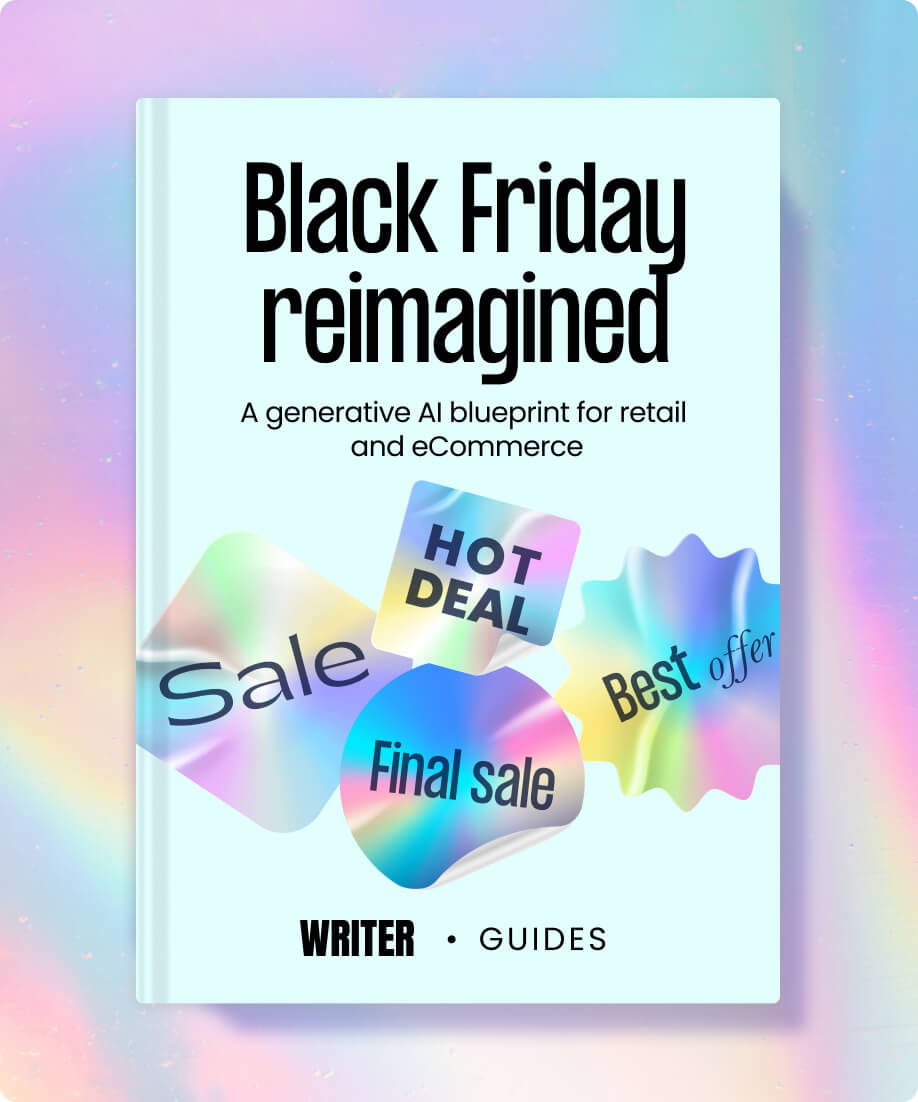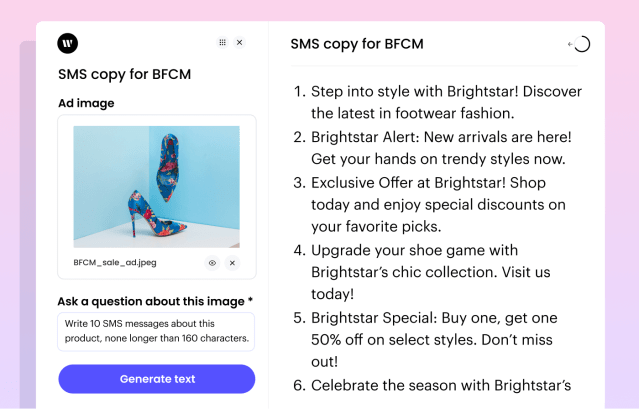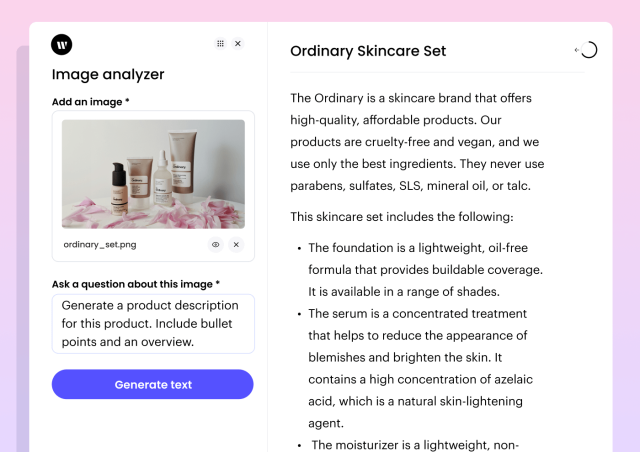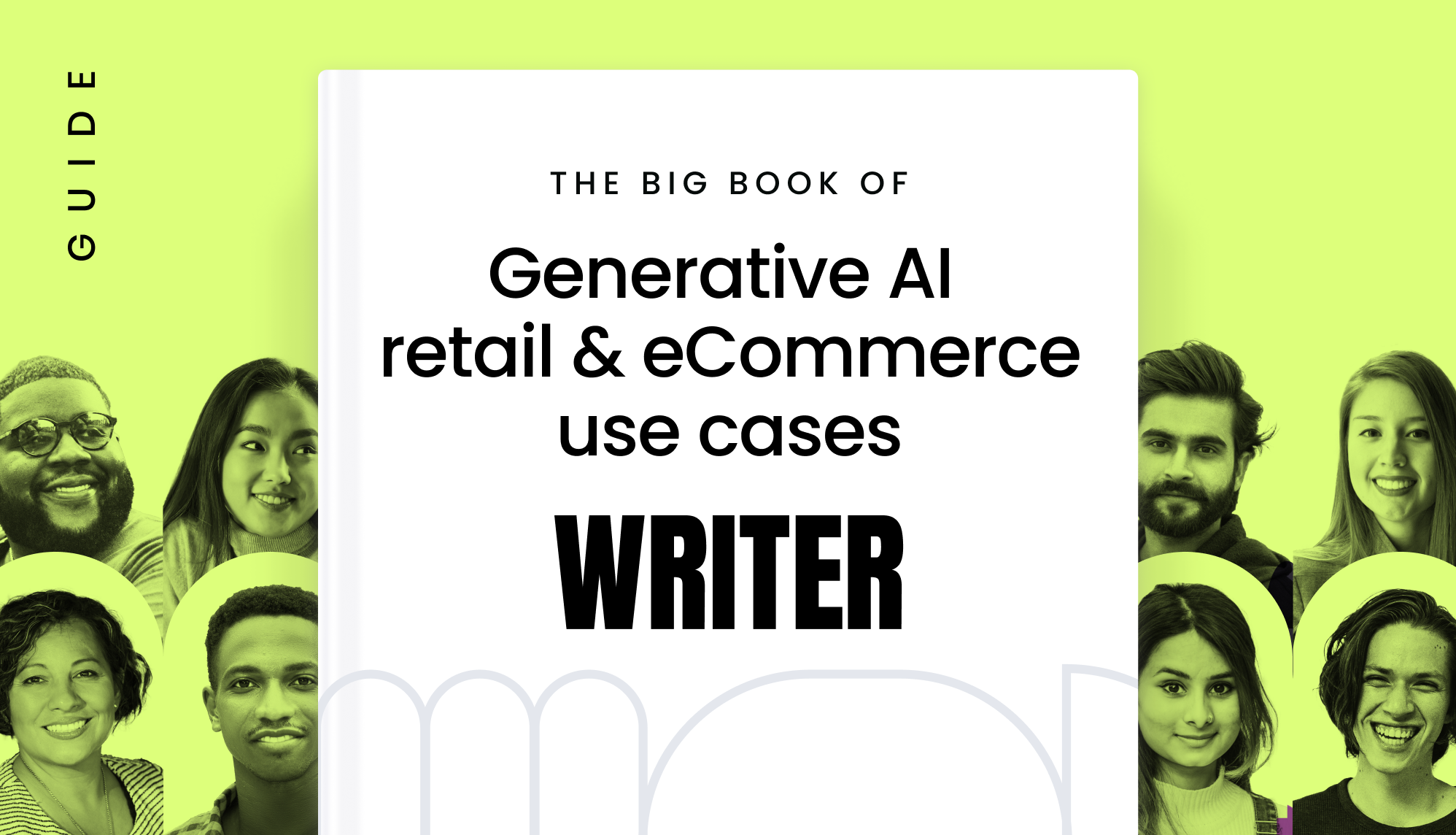Black Friday reimagined
A generative AI blueprint for retail and eCommerce

Introduction
Imagine a Black Friday and Cyber Monday where your entire organization works in sync. The marketing team drafts dozens of integrated campaigns in minutes. Customer service glides through the inbox without breaking a sweat. And the operations team has forecasted just the right amount of inventory for demand.
You could have a more successful Black Friday/Cyber Monday (BFCM) — and even free up resources so team members can focus on other areas of the business, like:
- Optimizing your digital shelf
- Hiring and onboarding a new team member
- Improving your mobile experience
- Projects that often have to wait until Q1, when the holiday madness is over
This isn’t just a dream. It’s possible with generative AI. And it’s already happening in global retail as eCommerce leaders embrace the technology — giving them a leading edge amid industry headwinds.
Black Friday reigns as the biggest shopping event of the year. Last year alone, consumers spent a record $240.1 billion online during the holiday season. That marks a 8.4% increase from the previous year.
Despite this growth, new challenges make it harder for retailers to take advantage of the holiday hype:
- Inflation is putting pressure on brands to limit price increases for consumers even as operating and material costs are going up.
- Escalated eCommerce growth means customers have more choices than ever. They’re pickier and less loyal to particular brands.
- Consumers are losing interest in Black Friday sales.
This event already lights a fire under every team. But these added challenges mean brands need to put in more effort to draw in customers and earn a healthy profit.
Enter generative AI.
AI augments human teams by allowing them to:
- Generate high volumes of text outputs quickly based on company data
- Synthesize lots of data to surface insights
- Automate recurring tasks like campaign asset creation, product descriptions, and process documentation
- Identify patterns in customer feedback
- Review text for brand and legal compliance
Ultimately, AI helps your brand optimize operations, deliver great customer experiences, and maintain consistency and compliance. So even amid the holiday frenzy, you can amplify your impact without straining your budget and exceed your goals for your best Black Friday yet.

Download the ebook
A quick note on generative AI solutions
When implementing generative AI within an enterprise, there are three main options:
- Build a custom stack in-house
- Use individual AI apps for specific use cases
- Adopt a fully-integrated platform that serves the entire organization
Each approach has its own set of advantages and drawbacks.
1. In-house custom stack
To build a custom AI solution, you can create it from scratch or use pre-built foundation models to develop a custom application tailored to your specific business needs.
Advantages
Customization: Allows for high customization to meet specific business requirements and workflows.
Security: Enterprises maintain complete control over integration and application, including data handling and model training.
Drawbacks
Resource-intensive: Requires significant investment of time and expertise to set up the model, integrate data sources, and develop applications.
Delay to value: It takes significant time before a custom-built AI solution becomes fully operational and can start being used by an organization.
Ongoing maintenance: Continuous maintenance is needed to keep a custom stack operational and update features, so it will consume resources on an ongoing basis.
2. AI point solutions
This approach involves using standalone “wrapper” applications that are typically built on top of existing large language models — or AI features added to existing software. These apps are designed to perform specific tasks and are great for incremental productivity and personal work.
Advantages
Optimized for specific use cases: Because individual AI apps are tailored to address particular tasks or challenges, they’re highly efficient and effective for targeted business needs.
Ease of use: These apps are generally user-friendly and require less technical expertise to deploy compared to building an in-house solution.
Speed: Faster to deploy as they are pre-built and require only configuration rather than full development.
Drawbacks
Limited customization: While some apps offer configuration options, they’re less customizable to organizational needs than an in-house solution.
Lack of governance across the organization: Using individual apps may lead to a lack of consistency and standardization across the organization. This could lead to issues with compliance, security, and uniformity.
Dependence on vendor: Reliance on the app provider for updates, security, and functionality, which might limit flexibility and control.
3. A full-stack platform
A full-stack platform like WRITER provides a comprehensive generative AI solution that includes everything from the foundation model to application layers, integrated into a single platform.
Advantages
Governance: Enables enterprises to enforce legal, regulatory, and brand compliance across the organization. This mitigates risk and ensures all AI outputs adhere to company and industry standards.
Enhanced security: Consolidating your AI tech stack means less information is spread across disparate systems with different data privacy policies.
Support and updates: Vendors provide ongoing support, updates, and compliance with industry standards, reducing the burden on internal teams.
Flexibility: With the right full-stack platform, you can build custom workflows. For example, in WRITER, you can build AI apps to leverage AI for specific use cases across your organization.
Drawbacks
Cost: Can be more expensive upfront compared to individual apps due to the comprehensive nature of the service.
Your choice of AI solution depends on your specific needs, resources, and strategic goals. Each option offers different levels of control, customization, and complexity.
Marketing
Equip your marketing team for Black Friday success
Your marketing team pulls significant weight when it comes to BFCM. They determine the best channels and partners to bring in revenue. They create a plethora of promotional content. They track and optimize campaigns in real-time on the big day to make sure everything is performing well. All to draw customers in without breaking the bank.
And in 2025, pressure is mounting.
Shoppers are more discerning amid economic headwinds. And they’re becoming disenchanted by traditional Black Friday deals. In 2023, 52% of Americans said they didn’t plan to shop on Black Friday. And 62% of those who opted out believe better deals could be found at other times of the year. So creating compelling campaigns is all the more challenging.
Beyond challenging consumer sentiments around BFCM 2025, retail marketers are also facing limitations on how and where to launch integrated campaigns. Google’s Privacy Sandbox among other recent consumer privacy measures and a looming potential TikTok ban spell trouble for marketers. Brands need to diversify their efforts, prioritize owned channels, and personalize experiences to earn and keep customer attention as they lose access to consumer data.
Amid this challenging environment, generative AI is emerging as a life-buoy for retail marketers. It’s the solution marketers need to overcome these challenges. It amplifies marketing performance in a way that humans can’t do alone. And it saves marketers time so they can focus on responding to these challenges with strategy and creativity.
Take lingerie brand Adore Me, for example. By harnessing AI for a variety of use cases — including product descriptions and personalized customer communications, the team has saved 35 hours per writer per month — that’s like boosting capacity by an entire work week every month.
They’ve also seen a 40% increase in non-branded search traffic, have reduced time to launch campaigns to new markets to ten days (instead of months), and can create 2,900 product descriptions in minutes.
This Black Friday, AI can be your marketing team’s defense against accumulating challenges. And your brand could stand to see its best Q4 yet. Here are some tangible ways generative AI can support your marketing team this holiday season.
Generate on-brand marketing copy quickly for Black Friday campaigns
According to Attentive, successful brands send 3x the number of SMS campaigns in November as they do in a typical month. And that’s just for one marketing channel.
With the help of AI, your marketing team can scale campaign creation and generate the copy they need in a fraction of the time.

Optimize Black Friday campaigns effectively
Lots of campaigns mean lots of tests, as your marketing team figures out what copy and creative works best.
Generative AI can speed up marketers’ optimization processes and help them iterate more effectively to achieve better engagement and conversions.
For example, using a fully-integrated generative AI platform, marketers can:
- Identify the best-performing offer types from previous sales data.
- Fast-track testing by creating copy variants for A/B tests.
- Optimize landing pages for holiday-related SEO keywords.
This is more effective than doing it manually because AI quickly synthesizes data across multiple sources. The result: more precise strategic insights that can be put into practice faster.
Identify the best promotional opportunities
Your marketing team needs to prioritize tactics that result in conversions for BFCM.
AI can help your marketing team:
- Determine the best channels to prioritize based on sales data.
- Identify the most effective partners, such as affiliates and influencers, for BFCM promotions.
- Surface patterns from customer surveys to learn what impacts their purchasing decisions.
Manually, this is a cumbersome and time-consuming process. In the rush to get something live on time, marketers may rely on instinct or look at only a portion of the data. AI lets your team make better decisions considering all the context they have.
Run a Black Friday post-mortem
Next year’s Black Friday starts as soon as this one ends. When holiday shopping is over, your team needs to evaluate what went well and what could be improved for next year.
But there’s a lot of context they need to bring together to paint an accurate picture of the brand’s success on Black Friday:
- Overall sales data
- Campaign performance on every channel
- Customer feedback in surveys and reviews
- Sentiment on social media and online reviews
And they’ll need to tie in context from other teams — like customer service and operations — and external factors — like the current economic climate and other events that may impact consumer behavior.
AI lets the marketing team discern patterns and uncover any gaps or opportunities from the wealth of data at their disposal. Then, quickly synthesize their findings into actionable insights to communicate to stakeholders.
Black Friday generative AI use case examples for marketers

| Type | Example |
|---|---|
| Create | Create an SMS campaign from this Black Friday email. Generate a script for a promotional video that showcases our Black Friday deals for Instagram. Create a witty version of this ad copy we can use for A/B testing. |
| Analyze | What were our best-performing types of offers for all the sales we ran in the past year? Which influencers drove the most revenue this year? What was the overall customer sentiment in response to our social media campaigns? |
| Govern | Review this PDP copy for ESG compliance. Re-write this holiday gift guide to follow our new brand guidelines. Flag off-brand terminology in our social media campaign copy. |
Creative
Optimize your creative team’s Black Friday process
Creative teams have three main challenges as Black Friday approaches. They need to:
- Run efficient photo and video shoots that capture a variety of angles and emotions and showcase the product in use.
- Design product packaging that captures consumer attention in digital mediums and on retail shelves as shoppers engage in a healthy blend of shopping in-store and online.
- Create the high volume of marketing campaign assets that are necessary for every marketing channel.
In this high-pressure scenario, AI emerges as a crucial ally for creative teams. Generative AI offers creative teams significant benefits by automating time-consuming, repetitive tasks and streamlining collaboration and workflows.
Streamline preparations for photo and video shoots
AI speeds up the mundane, repetitive tasks that get in your creative team’s way, like managing logistics for photography and videography shoots.
AI can create:
- Call sheets for talent and crew
- Equipment checklists including outfits and props needed for the shots
- Shot checklists so the marketing team gets everything they need for campaigns
The creative team can train generative AI software on all their typical documentation to maintain consistency while making updates as needed for each resource.
And after the photoshoots are done, AI can analyze images to generate metadata, alt text, and tag suggestions to keep everything organized.

Develop Black Friday styling and art direction concepts
Generative AI can also help the creative team come up with new image concepts and art direction on the fly. This facilitates diversity in ideation when there are a lot of assets to be made.
By supplying AI with information about the product and offer, it can help come up with:
- Image concepts that show off the product
- Composition, lighting, color palettes, and mood to suit the concept
- Location ideas that complement off the product
Then, the creative team can incorporate all this information into the briefs they create for stylists and photographers.
And by training AI on existing images and creative briefs, it can come up with concepts that suit the brand.
Black Friday generative AI use case examples for creative teams

| Type | Example |
|---|---|
| Create | What are three image concepts that will show off this product’s features? Create a brief for our stylist that communicates the art direction and styling needs for this photoshoot. Write a shot list based on the marketing team’s list of needs.
|
| Analyze | What were our best-performing image types from last year’s Black Friday sale? Which packaging design led to the most sales? What were our top performing social media campaigns from our sales this year?
|
| Govern | Review this ad image for ESG compliance. Ensure this image contains accurate product information. Is there any off-brand terminology in this ad image? |
Customer service
Empower customer service teams to meet Black Friday demand
64% of businesses say customer support is a top business area for generative AI to streamline processes and improve customer experience.
It’s no wonder when you think about what customer service teams manage during the holiday season. Customer inquiries are through the roof, with close to 50% more total chatbot sessions and calls reported during Cyber Week (Thanksgiving through Cyber Monday) than usual. There are new products and offers to keep track of. And standard policies like shipping and returns might be different during the holiday season.
They have to keep track of all of this while maintaining high levels of customer satisfaction and service quality. Considering that half of consumers may reduce or completely stop spending with a brand after just one bad experience, slowing down responses or using inadequate tools aren’t feasible options.
AI equips customer service teams with the knowledge they need and allows them to speed up support for high service quality.
Prepare documentation for Black Friday volumes
To provide the best possible customer service during the holiday season, support teams at retail brands can use AI to prepare necessary documents in advance.
This includes:
- Analyzing customer conversations to identify common issues that could be covered by documentation.
- Creating help docs and FAQs for customers to answer their own questions.
- Writing templated responses to address common inquiries.
- Updating policy pages to accommodate holiday-specific policies.
Doing this can reduce overall support volume and speed up resolution time.
Speed up agent responses during the busiest time of the year
Writing templated responses in advance can speed up customer service. But to further enhance responsiveness, AI can act as an expert assistant with deep knowledge of all your internal documentation.
At a company with dozens or hundreds of SKUs, there’s no way customer service agents can maintain expert knowledge of all of a brand’s products. And shifting holiday policies can add more knowledge gaps for service agents.
So it’s helpful to have an AI platform that’s ingested all of your company’s documentation that customer service agents can query against. For example, with WRITER, it’s easy to set up a Knowledge Graph of your company’s support documentation — no need to do a bunch of prep work or engineering work.
Then as support agents encounter questions they don’t know the answer to, they can find the answer quickly and trust that they’re relaying accurate information.
Optimize seasonal customer service coverage
Retail teams need to expand customer service coverage during the holiday season to account for the increased support volume.
This means optimizing your support schedules with your existing staff based on your projected customer inquiries volume and then hiring seasonal staff to fill in the gaps.
Instead of doing this manually, service teams can speed up the process with generative AI by:
- Analyzing historical data from previous Black Friday sales periods to predict customer inquiry volume.
- Identifying peak times when inquiries are highest.
- Suggesting a support schedule for the best coverage based on the capacity of existing support staff.
- Recommending how many additional seasonal staff need to be hired.
Beyond time savings, optimizing schedules with AI means more accurate predictions so your team doesn’t under- or over-staff.
Train support staff on Black Friday processes
For Black Friday, existing support staff will need to be trained on any new policies and procedures. And seasonal staff will need to be trained quickly from the ground up.
AI can streamline training by:
- Creating standard operating procedures (SOPs) for new support staff.
- Updating SOPs for season-specific processes and outlining changes for current staff.
- Simulating customer service conversations and evaluating new hires’ responses against the policies the company has and providing guidance for improvement.
- Connecting a custom chatbot using graph-based retrieval-augmented generation (RAG) to the company’s wiki and onboarding materials for quick question-answering.
These use cases enable customer service teams to confidently handle the influx of inquiries while delivering exceptional support throughout the busy shopping period.
Identify patterns in customer conversations and feedback
Identifying recurring issues or concerns allows customer service teams to address them proactively and prevent similar problems in the future. For example, technical glitches, delayed deliveries, insufficient product information, or inadequate service.
But going through conversations and reviews manually is too time-consuming and it’s challenging to identify the most common issues.
Using Al, your service team can identify the most common recurring issues and communicate those to the appropriate team.
Black Friday generative AI use case examples for customer service

| Type | Example |
|---|---|
| Create | Rewrite our shipping FAQs with our updated Black Friday policies. Generate a summary of changes between our old SOPs and the new ones. Create an SOP document that describes how to edit a customer’s order. |
| Analyze | What are the most common questions our customer service team receives? What are the most common customer complaints in product reviews? How long is our extended returns window for Black Friday? |
| Govern | Review recent customer service conversations to make sure support agents are using approved product names. Review new staff members’ responses for accuracy. Review these FAQs for accessibility. |
Operations
Boost your operations team’s efficiency and impact
For operations teams, accurately predicting demand and stocking the right amount of product for BFCM is a persistent challenge. The surge in demand, if not accurately anticipated and prepared for, can severely slow down fulfillment processes, leading to delayed deliveries and dissatisfied customers.
And global trade greatly impacts operations teams. 35% of US companies report that most of their manufacturing is done outside the US. And even if manufacturing is done in the US, materials may be imported from abroad. With lingering memories of the supply chain disruptions of 2020 and 2021, operations teams need to stay flexible to manage unforeseen risks while maintaining efficiency.
Generative AI can help uphold efficiency by streamlining activities across logistics processes.
Forecast Black Friday demand to avoid stock issues
Understocking and overstocking are both bad news. Understocking means your company misses out on valuable sales. Overstocking means your brand risks liquidating it later to clear out excess. Either way means lost money.
Generative AI enables more accurate demand forecasting. By leveraging historical sales data, AI can provide more accurate recommendations to:
- Manufacture sufficient volume
- Determine how much stock to send to warehouses and retail stores based on geographical sales
- Stock enough packing materials
This sets the stage for a smooth and profitable Black Friday.
Train logistics staff on Black Friday processes
With the influx of orders during Black Friday and Cyber Monday, training staff is critical to maintaining operational efficiency.
Operations teams can use AI to quickly train staff by:
- Creating SOPs for seasonal logistics staff.
- Updating SOPs for season-specific processes and outlining changes for current staff.
- Simulating logistics scenarios, like quality issues that arise during returns refurbishing, and evaluating new hires’ course of action.
- Connecting a custom chatbot that uses graph-based RAG to the company’s wiki and onboarding materials for quick question-answering.
AI facilitates proper staff training, fostering a well-coordinated workforce.
Black Friday generative AI use case examples for the operations team

| Type | Example |
|---|---|
| Create | Write a refurbishing SOP document for this new product. Update our SOPs for our new holiday processes and outline the changes for staff. Create an SOP document that describes how to edit a customer’s order. |
| Analyze | What products did we sell out last Black Friday? Which products do we have excess stock of? Which of our US warehouses send out the most orders? |
| Govern | Test new staff members’ knowledge of our pick-and-pack process. Review this seasonal job listing for inclusivity. Identify any staff members whose safety certifications are expiring soon. |
Product
Transform your product team’s market response
One of the primary challenges product teams face when prepping for the holiday shopping season is the tight deadlines under which they operate. They need to develop exciting new product concepts or create limited-edition SKUs early enough to test, manufacture, stock, and photograph before the big day.
Evolving consumer preferences further amplify this challenge. In 2025, the impacts of inflation are causing shoppers to trade down while at the same time signaling their intent to splurge. They have more options than ever thanks to eCommerce growth. And shoppers are becoming increasingly conscious about the sustainability of their purchases, as products making environmental, social, and governance (ESG) claims averaged 40% more cumulative growth from 2017 to 2022 than products that didn’t.
Altogether, this means product teams need to differentiate products better while taking environmental impact into account and maintaining the price ranges their customers expect.
The good news is that generative AI can help product teams accelerate design processes to meet tight Black Friday deadlines with standout products.
Ideate new product designs
By identifying patterns in customer data, product teams can develop new products or introduce limited-edition variants that increase the likelihood of success during Black Friday.
AI can help brainstorm innovative products or enhance existing ones by:
- Identifying the products and features that resonate most with customers based on sales data, reviews, and feedback.
- Pinpointing recurring quality issues and making new feature or product recommendations.
- Generating fresh product concepts using information about current products and customers.
AI allows product teams to harness all the resources at their disposal to identify opportunities that truly meet customer needs and desires.
Communicate product information to other teams
When product designs are finalized, other teams need product information so they can prepare for Black Friday effectively.
The operations team needs to determine the right size packaging. Customer service needs to add product details to their knowledge base. Creative teams need to plan media. And marketing teams need to turn features into captivating product descriptions.
Generative AI can extract product specs and features from technical documents and design files so product teams can communicate this information thoroughly and efficiently.
Then all teams have accurate and up-to-date information to effectively promote and sell products during Black Friday.
Black Friday generative AI use case examples for the Product team

| Type | Example |
|---|---|
| Create | What are some product ideas that would complement our current product line? Generate a list of product specifications from this design file. Create a survey to gather customer feedback. |
| Analyze | What is our most common feedback about this product? What are our most requested features? What are the most frequently purchased colorways of this product? |
| Govern | Review this PDP for product information accuracy. What is the status of this product’s patent? Establish quality control protocols for this new product. |
Legal
Streamline your legal team’s review and approval processes
Legal teams are the guardians of compliance. They must make sure that every department adheres to a complex web of policies — particularly in light of new consumer privacy laws.
Additionally, the responsibility of securing sound contracts and acquiring necessary patents and trademarks falls on their shoulders. These tasks are critical for protecting the brand’s reputation and financial health.
All of these responsibilities are magnified during Black Friday. AI can help the legal team reduce their workload by mitigating the risk of non-compliance across the organization.
Review contracts in preparation for Black Friday
All contracts need to be reviewed meticulously to safeguard the company’s interests and maintain compliance.
And in preparation for Black Friday, many contracts are executed across the organization. Marketing may sign contracts with new partners. Creative will hire models and photographers. Product may collaborate with artists or celebrities. Logistics may sign with a new distributor or shipping partner.
Any third-party contract or updated internal contract needs to be evaluated by legal before it’s signed.
While your legal team will want to scrutinize everything manually, AI can speed up the review process by:
- Identifying flaws in contracts before review, so the associated team can make changes proactively.
- Double-checking for potential errors a human may have missed.
- Enabling the legal team to ask specific questions about a document and getting accurate answers.
By integrating AI into the contract review process, your legal team can ensure that all agreements are thoroughly vetted.
Guarantee compliance of public-facing language
The legal team doesn’t review every public-facing communication — like marketing campaigns, website copy, or customer service emails. But all of this communication needs to adhere to strict regulatory standards.
AI can play a crucial role in maintaining compliance across departments by:
- Recognizing and flagging content that may violate advertising or privacy laws.
- Highlighting banned terms as determined by the legal department, for example, to maintain ESG compliance.
- Ensuring proper disclosures on terms and conditions and other policies.
By leveraging AI to oversee compliance in public-facing elements, companies significantly reduce the risk of legal penalties and maintain their reputation.
Streamline intellectual property filing
New products can’t launch without the proper patents and trademarks in place.
It can be time-consuming to review all the documentation about a product and draft a patent or trademark application from scratch.
AI can help by analyzing technical product documents, research papers, summaries from clinical trials, and other relevant information. Then, it can draft a comprehensive, accurate application.
Black Friday generative AI use case examples for the Legal team

| Type | Example |
|---|---|
| Create | Review this contract and give a summary of any potential issues. Provide a summary of our clinical trial for this product. Draft a patent application for the technology used in this product. |
| Analyze | What does the contract termination clause state? What is the status of our trademark for this product name? How many safety concerns have customers reported for this product? |
| Govern | Review this press release for ESG compliance. Are all the necessary disclosures included in our terms and conditions? Identify staff members who have not yet signed an NDA. |
Functional requirements for a generative AI solution
With the right tools in place, all these Black Friday-elevating use cases are possible. When choosing a generative AI solution, here are the capabilities your software should have:
- Knows your products
- Adheres to your legal and regulatory rules
- Speaks in your voice
- Writes in your style
- Integrates easily into existing workflows
- Understands relevant data formats
- Detects claims and checks facts
- Protects everyone’s data (yours and your customers)
- Meets the compliance needs of secure organizations
- Gives business users and engineers alike the tools to build their own custom AI apps and workflows

Want ideas for accelerating your retail and eCommerce business beyond BFCM?
Check out the guide